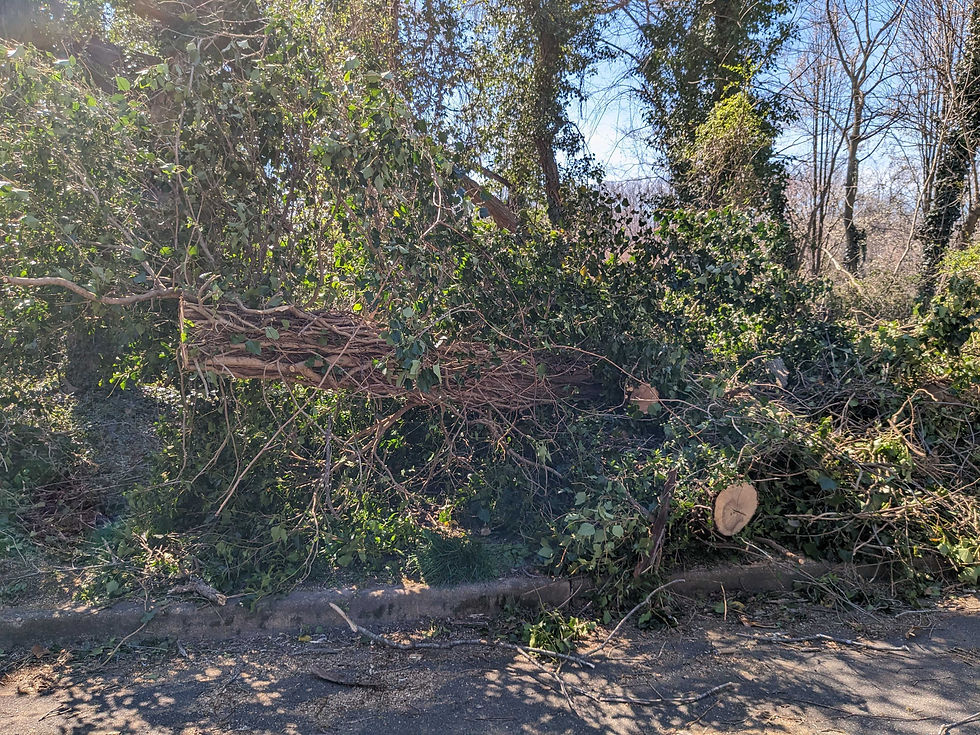Laying The "Groundwork" This Winter
- earthsangha
- Mar 16, 2023
- 3 min read
As volunteer coordinator, I have the privilege of spending a lot of time with the folks that help make the conservation work we do possible. That work isn’t usually easy, but most people find that the rewards outweigh the challenges. This February, Earth Sangha volunteers and staff embraced that notion and spent 375 cumulative hours pulling invasive vines and shrubs. During those many hours, we shared a lot of stories, had a lot of laughs, ate a granola bar or two, and got to know each other and the plants we were rescuing – and removing – a bit better. Despite unpredictable weather conditions (remember those cold rainy mornings?) and facing near impenetrable thickets (SO MANY PRICKLES!), we donned our jackets and gloves, grabbed our loppers, identified the target species for the day, picked an area, and got to work.

Pictured above: Volunteers and staff removing invasives along the forest edge at Rutherford Park. The Earth Sangha started working at Rutherford Park in the mid-2000's as a part of our stream-buffer restoration program.

We labored mostly in forest-edge habitats and focused largely on the usual suspects: English ivy, porcelain berry, oriental bittersweet, Japanese honeysuckle, wintercreeper, wineberry, Amur honeysuckle, privet, winged Euonymus (burning bush), and multiflora rose. The mounds of invasive plant material gathered at each site at the end of each day were astounding.
If I had to choose an invasive plant that was the most satisfying to remove, it would be multiflora rose. With this multi-stemmed shrub's ability to reach 10 or more feet, pulling one out of the landscape makes a marked difference, not to mention the rose’s propensity to fight back with its needle sharp curved prickles makes it a worthy adversary.
Pictured right: Matt Fisher, one of our 2023 Conservation Interns, dragging away one of many massive sled loads of bush honeysuckle and multiflora rose removed from the Marie Butler Leven Preserve!
On the other hand pulling and cutting invasive vines is extremely rewarding because they cause such devastation. Invasive vines can climb into the canopy, weighing down native tree species. Sometimes this leads to broken branches or deformed growth or even brings the tree down entirely. The dense shade of invasive vine curtains shades out and smothers native trees and shrubs along forest edges. Adding to the burden, some species of invasive vines like Japanese honeysuckle and oriental bittersweet, are known to girdle trees, which prevents the flow of nutrients to and from the leaves and roots, spelling certain death.

Pictured above: A mature black locust brought down by severe English ivy infestation. Matt spotted this downed tree while on a site visit to a restoration site along Little Hunting Creek.
Working as volunteer coordinator for over a year now, I’ve noticed different ways in which people tackle multi-species plant removal. After choosing a section, some folks go after one species at a time, clearing an area as one peels an onion–one layer at a time. Other folks clear their chosen area of all identified species as they come across them, creating “clean” spots as they move. There are those that seek out and destroy the biggest or most difficult plants they can find, usually oriental bittersweet or multiflora rose. I myself tend to vary my approach as the occasion or site dictates. Regardless of approach, their diligent actions have an immediate and positive impact on the environment.
Controlling invasive plants is Earth Sangha’s proverbial “groundwork”. It is a first step in conservation because it allows us to rescue already established native plant populations in situ. Clearing out sections of invaded parkland also provides us time and space to come back later to replant in an effort to reinvigorate and repopulate a site when needed. In that way invasive plant removal is the basis for the work we do at the Wild Plant Nursery.

Pictured above: The Earth Sangha team removing Japanese honeysuckle from the deer exclosure fence at Laurel Hill Park. This fence is protecting hundreds of native oaks and hickories we installed in partnership with the Fairfax County Park Authority in 2021 and 2022. One of our big priorities for 2023 is returning to old worksites to evaluate planting for needed maintenance or additional plantings.
Experience tells us that repeated efforts to remove invasive plants from an area works, and with the hundreds of volunteer and staff hours this past month, we continue to put conservation into practice to save what we can and restore a little of what’s already been lost. And although we made great strides, there is still more to do. See you in the field!
Sarah Mard
-Volunteer Coordinator
Recent Posts
See AllDear Friends, Just a few months ago I wrote how we will continue to focus on our conservation work – work that takes time to yield...



























As you start laying the groundwork this winter, don’t forget to grab a stylish Phillies Jacket from Team Jacket Shop to stay warm and show your team spirit!